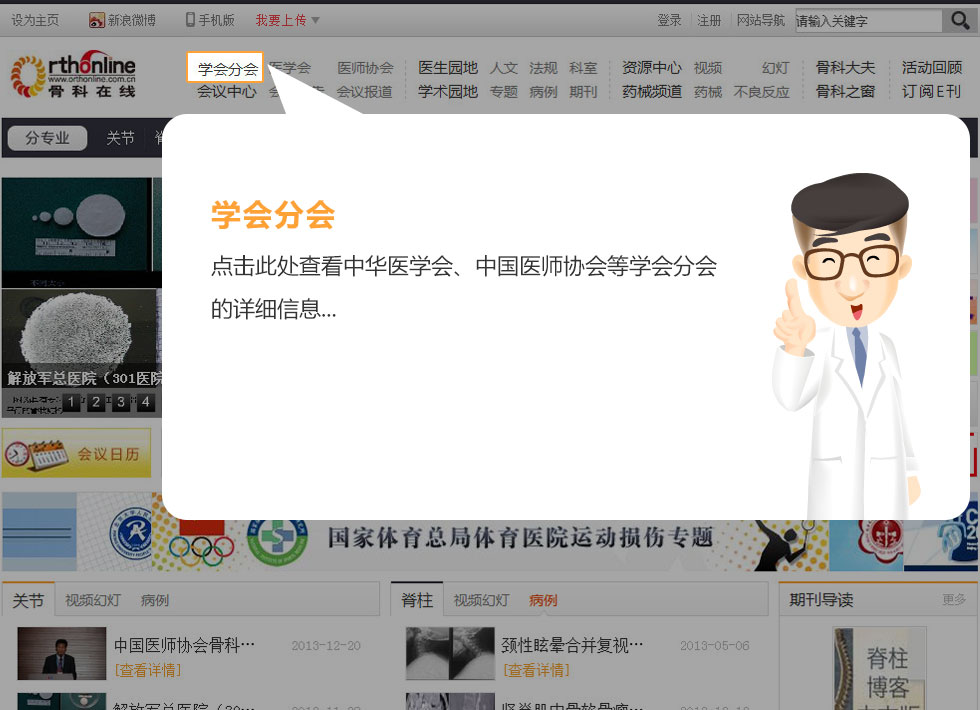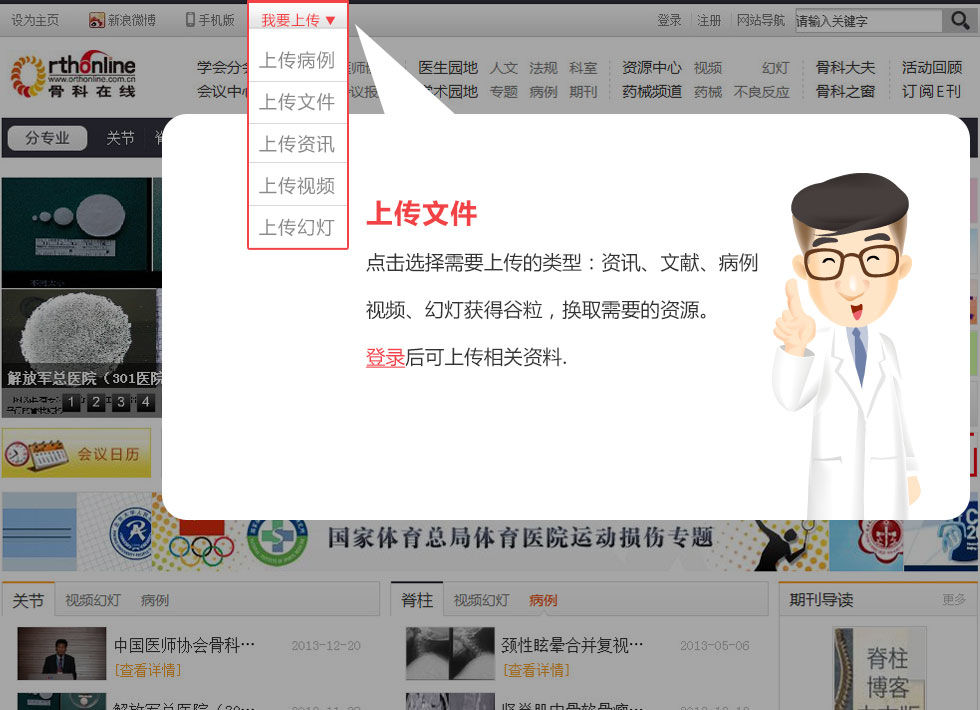抗生素骨水泥防治人工关节置换感染
2011-12-01 文章作者:shenjie 我要说
骨科在线版权所有,如需转载请注明来自本网站
由于交通和经济的发展及人口的老龄化,人工关节的例数正逐年剧增。感染是其灾难性的并发症。虽然随着外科无菌技术的发展及手术室层流技术的使用,人工关节置换感染的发生率已下降到了0-4% [1,2] ,但由于这类手术的大量进行,感染的病例数仍不断上升。同时,感染的治疗充满了挑战性,住院治疗康复时间长[3],相关死亡率高达7%至62%[4],相关治疗费用也高达一般关节置换术的三到六倍[5-7]。所以如何有效的预防和治疗人工关节置换后感染一直是困扰着临床关节外科医师的问题,也是关节外科领域一个非常重要的课题。
1970 年,Buchholz 和Enelbrecht 首次将抗生素骨水泥应用于关节置换感染的治疗,随后抗生素骨水泥被广泛应用于预防和治疗人工关节置换的感染。尽管抗生素骨水泥的药释特性、抗菌疗效和安全性已得到充分肯定和循证研究证实,但在广泛应用后也暴露大量问题,诸如药释性能不充分、可致细菌黏附、细菌变异耐药甚至生物膜形成等。本文对抗生素骨水泥抗生素的选择、洗提特性、物理特性、临床应用及安全性等最新研究进展做一综述。
一、骨水泥中抗生素的种类
抗生素骨水泥在局部释放抗生素发挥预防或治疗感染的作用,可以选择的抗生素多种多样,理想的抗生素应尽可能具备以下条件:①抗菌谱广,抑菌浓度低。尤其对预防性使用的病例,要求迅速彻底的杀灭进入手术创面的所有细菌及微生物。②安全性高。局部使用抗生素与全身使用一样,要求抗生素是对人体安全的,尽量避免药物毒性及不良反应。③耐热性好。抗生素必须在骨水泥聚合的过程中耐受高温[8],而不被分解或灭活。如林可霉素、四环素类抗生素的热稳定性差,故不适合使用[9]。④水溶性。药物通过溶解于局部组织液弥散分布。⑤低致敏性。至今尚未发现与抗生素和骨水泥反应相关的半抗原介导过敏反应,若全身使用无过敏史,则在局部应用也是安全的。
在欧洲最普遍使用的是庆大霉素[10-13],每40g 骨水泥中含0.5-1g 剂量的庆大霉素在临床已经被证实是安全的,所以商业化生产的抗生素骨水泥也多是采用这种配比[14];在美国妥布霉素是最广泛使用于抗生素骨水泥的,在一项调查统计中显示70%的抗生素骨水泥使用妥布霉素[15],其抗菌曲线类似于庆大霉素[15,16]。其它可使用于骨水泥的抗生素还有:万古霉素、先锋唑啉、头孢呋辛、青霉素等,另外治疗霉菌感染还可使用两性霉素B 骨水泥[17-19]。
二、抗生素的剂量
抗生素的剂量要根据使用的具体情况,预防使用时要求骨水泥含小剂量的抗生素避免骨水泥机械效应的影响,因为这是用于固定假体或内植物。一般来说,小剂量是定义为40g 骨水泥中含1g 抗生素;在治疗已确诊的感染时,骨水泥的珠链或间置器是要包含大剂量的抗生素以保证清除感染(表1) [2]。
三、抗生素释放的物理机制
研究表明抗生素的洗脱主要发生于以下3 个时期[20]:爆发期—洗脱率极高,并发生于前24 小时以内;降低期—洗脱率降低;末期—洗脱率极低且稳定,并最终到达一个恒量。有一点得到共识的是抗生素丙烯酸骨水泥不亲水,它的基质不具渗透性,因此抗生素无法扩散。爆发期是一个表层效应,这种效应还取决于骨水泥的多孔性以及表面的湿润性。表面多孔程度决定了骨水泥的粗糙程度,继而决定了能够接触其表面参加抗生素洗脱反应的液体总量。液体的渗透促进了抗生素洗脱,这些液体接触表面渗透到骨水泥中众多互连的空隙与细缝之中[21]。如此,只有位于流入液体通道层中的抗生素能够溶解通过这些空隙与细缝(吸附的抗生素粒子)然后发生洗脱反应。此外,接近表面的抗生素粒子也会引起一些洗脱。第二阶段中(尤其是在36-72 小时内),由于在第一阶段末只有小部分抗生素分子存留,并且这些抗生素被基质覆盖,保护其不被液体溶解[22]。第三阶段(平稳期﹥14天)说明这是一种特殊溶液化学现象22。
总的来说,广泛认可的影响抗生素释放的因素有;抗生素的种类和比例,抗生素的量,骨水泥的种类、孔隙率和表面积,骨水泥制备的方法。一般来说,抗生素骨水泥中的抗生素含量越多,释放越多,如Drognitz 等[23]认为骨水泥中抗生素的释放可能是通过浓度梯度的弥散作用。所有的抗生素中以氨基糖甙类的药释性能最强,其次为万古霉素[24]。
四、骨水泥的种类
在众多骨水泥中Palacos 一直被认为是具有最佳洗提效应的骨水泥[25,26],然而更新的骨水泥品种表现出相似或更优的药代动力学效应[27-30]。
骨水泥的表面积和孔隙率是决定性的因素[28,31,32],一项研究表明增加40%抗生素骨水泥的表面积,可以提高抗生素的释放达20%[33]。
五、骨水泥的搅拌方式
手工混合优于真空搅拌,因为更多的夹带空气以增加骨水泥的孔隙[28]。液体抗生素能够提高抗生素的洗提,但由于它对骨水泥力学特性的负面影响不能用于假体的固定,但可用于治疗型骨水泥,Seldes 等[34]发现在骨水泥中加入液体庆大霉素会降低抗压强度49%,降低抗拉强度46%。然而加入妥布霉素粉末就没有如此明显的影响。
预防型抗生素骨水泥理想的药物释放曲线:早期高浓度释放有利于药物杀灭术中污染的细菌并防止细菌黏附于假体或骨水泥,后期释放停止避免某些污染菌产生变异和耐药。治疗型抗生素骨水泥理想的药物释放曲线:早期不要求高浓度药物释放,应尽量保持后期药物平稳并以杀菌浓度持续释放,彻底杀灭残留细菌。现今抗生素骨水泥远远不能达到理想的药释曲线,所以大量的研究试图提高抗生素骨水泥的药释性能和抗菌疗效,代表性思路包括:超声促进药释、多种抗生素混合、添加增孔剂。
六、抗生素骨水泥的增效思路
低频超声可促进抗生素骨水泥的药物释放[35,36],严世贵等[37]报道将抗生素丙烯酸骨水泥植入到兔子的髋臼和股骨近端内。在念珠植入体内96 小时期间的4 个重要参数分别为:从髋关节抽取的关节液中的抗生素浓度、抽取的关节液中抗生素浓度的峰值、抗生素在尿液中的累积浓度和关节液中抗生素浓度高于最低抑菌浓度(MIC)的时间。与对照组比较,当周期性的使用低强度连续波超声时上述中前三个参量都有显著的增加。超声还与抗生素骨水泥间存在协同抗菌,其机理包括:微射流直接杀菌,预防细菌黏附,使生物膜脱离内植物[35];微声流促进抗生素穿透细胞膜或生物膜[38-40];超声促进氧气、养分、代谢产物、离子在生物膜内的转运,提高细菌的代谢水平,增强抗生素的敏感性[41]。在前瞻性的研究中,脉冲波超声(PWU)比持续波超声(CWU)更受推荐,因为它的大功率强度和低组织损伤风险[42].
多种抗生素间不仅可通过合作机制提高骨水泥的孔隙率促进抗生素的释放,而且可完善抗菌谱。
研究表明氨基糖甙类(庆大霉素,妥布霉素)和糖肽类(万古霉素)混合能够提供最大的协同效应,增加总的释放量[43-46]。
增孔剂则通过提高骨水泥的孔隙率而增加药物释放[47]。例如葡聚糖,甘氨酸,木糖醇,右旋糖酐[47-49],被加入骨水泥中以增加骨水泥的孔隙率,Kuechle 等[50]发现加入25% 的右旋糖酐可使抗生素的释放在第一个48 小时提高大约4 倍,同时使抗生素的释放持续时间从6 天延长到10 天。然而理想的填充增孔材料和填充物的量,仍然没有被确定。
七、抗生素对骨水泥物理性质的影响
骨水泥中添加抗生素对于骨水泥的固化及机械性能是否有改变,目前已成为广大学者关注的重点,尤其是抗生素骨水泥作为预防性使用。从理论上说,抗生素从骨水泥中析出,势必会造成骨水泥中许多细小的空隙存在,这些孔隙或多或少会对骨水泥的力学性能产生影响,但只要加入抗生素的剂量适当,就不会对骨水泥的物理及机械性能产生明显影响。目前骨水泥机械性能的测试方法有两种。一种是压力试验,另一种是四点弯曲试验。后者测试的是材料的抗压强度、弯曲强度和弯曲模量的指标。目前所有的普通骨水泥和抗生素骨水泥产品在静态压力试验中均能达到最低的承压标准70Mpa,且普通骨水泥与抗生素骨水泥也未发现有明确的区别;对于四点弯曲试验,目前市售的骨水泥均能达到要求,虽然抗生素骨水泥的弯曲强度会低于普通骨水泥,但两者在统计学上不存在差异[51]。一般用于假体固定的载抗生素骨水泥,剂量通常是40g 骨水泥加0.5-1g。每40g 骨水泥加入4.5g 抗生素仅适合作为治疗型骨水泥不能用在假体固定上的[52-54]。Klekamp 等[55]指出随着万古霉素和妥布霉素剂量的增加,骨水泥的抗疲劳强度和抗压力强度降低,骨水泥疲劳强度在加入1、2、3 g 万古霉素后分别降至90%、70%、50%,同样在加入1.2 g 和2.4 g 妥布霉素后降至80% 和60%,疲劳强度有显着性差异,而压力强度的下降趋势没有显着性差异。冻干的块状万古霉素明显降低骨水泥的强度。故建议固定假体时使用细粉掺入骨水泥,这样对水泥的强度损害最小。Bourne 认为[56]在关节置换手术中骨水泥强度降低10%以内是可以接受的,更低强度的骨水泥可用于链珠和间置器。
抗生素与骨水泥的混合方式也对骨水泥的机械性能有一定的影响。使用真空搅拌时,会明显减少固化骨水泥中的空泡从而增强其机械性能。有研究显示[57]真空搅拌可降低5 倍的抗生素骨水泥的孔隙率,但可能抑制抗生素的释放。抗生素与骨水泥搅拌应尽可能的均匀,这样可以减少抗生素对骨水泥的机械强度的影响。
八、抗生素骨水泥的临床应用
抗生素治疗确诊感染的患者是公认的方法,同时治疗方法也逐步形成了广为接受的二阶段模式。尽管抗生素骨水泥预防感染在欧洲已广泛的应用,但在北美仍有争议,直到2006 年FDA 才批准了6个市售抗生素骨水泥品牌的预防性使用。
抗生素骨水泥治疗关节置换感染
关节置换术后感染可分为4 型[58]: I 型-术后早期感染,II 型-后期慢性感染,III 型-急性血源性感染, IV 型-术中培养阳性,但临床症状不明显(表2)。在早期术后感染中抗生素骨水泥被制成珠链用于保留假体的治疗[59-61]。在慢性感染中应用抗生素骨水泥的二阶段返修手术最早在1983 年被Insall 等报道[62],目前已经成为治疗慢性术后感染的标准方法。Garvin and Hanssen 综合分析了29 项研究得出结果,应用抗生素骨水泥二阶段返修手术治疗关节置换感染,成功率达91%[63]。第一阶段手术彻底清创拆除假体,放置抗生素骨水泥间置器,其作用不仅局部直接释放抗生素,还能防止关节周围软组织挛缩、增加关节活动度[59,60,62,64-71]。待感染完全控制后,进行第二阶段手术,取出间置器重新安装假体,术中可选用抗生素骨水泥固定假体,预防再次感染[59,64,72,73]。关节间置器有关节型和非关节型,研究显示前者比后者有更好的效果。关节型间置器提供了更多的关节活动度和更好的关节功能,减少疤痕形成,使二期返修手术暴露更容易,减少出血,缩短手术时间[66,74,75]。
 抗生素骨水泥预防性使用抗感染
抗生素骨水泥预防性使用抗感染
1、抗生素骨水泥的临床疗效
大量的研究证明抗生素骨水泥是预防关节置换感染的有效方法[10,12,13,76-79]。一项报道分析了瑞典登记的92675 例骨水泥全髋初次置换的病例,发现抗生素骨水泥的使用是减少深部感染最显着的因素[80]。另一项研究报道了挪威登记的10905 例骨水泥型全髋初次置换的病例,认为抗生素骨水泥加全身应用抗生素的患者因感染返修的比率最低,单纯全身用抗生素的患者是它的4.3 倍,单用抗生素骨水泥的患者是它的6.3 倍,两者都不用是它的11.5 倍;同时它还能降低因无菌性松动返修的比率,其机理可能是一些低毒性感染导致的松动因为临床症状不明显被归为无菌性松动[11]。
Engesaeter 等[81]报道生物型全髋置换的感染率低于骨水泥型,但使用抗生素骨水泥使两者之间无显著性差异。他们的建议是术中使用抗生素骨水泥,术后当天静脉应用抗生素4 次。
2、抗生素骨水泥的指征
但是有许多学者认为在所有初次置换和无菌性返修病例中使用抗生素骨水泥是不合适的,应对普通和高风险患者加以区分。Jiranek 等[2]将高风险患者分为高污染组、有污染或感染史组、免疫力低下组(表2)。高风险患者组深部感染的发生率均高于普通组,使用抗生素骨水泥能显着降低感染风险。如Smabrekke 等[82]评估全髋手术时间超过150 分钟的具感染高风险率。Meding 等[83]报道了220例类风湿关节炎行保留交叉韧带的全膝置换术后,感染率为2.4%;Sharma 等[84]对36 例类风湿关节炎的全膝置换术后随访平均12.9 年,感染率为3.2%;Creighton 等[85]发现75 例类风湿关节炎全髋置换术后随访10 年,感染率为3%。但是liu 等[86]报道了60 例类风湿关节炎的患者应用抗生素骨水泥进行全膝置换,感染率为零。一项对糖尿病患者进行关节置换的随机前瞻性研究中,Chiu 等[77]发现162 例使用普通骨水泥的感染率为3.1%,178 例应用抗生素骨水泥的感染率为零。故在高风险患者中应用抗生素骨水泥预防感染是较为公认的方法,考虑到抗生素过敏、毒性及耐药菌形成等问题,在所有关节置换患者中常规使用抗生素骨水泥仍有争议。

3、抗生素骨水泥的安全性
载抗生素骨水泥的安全性已经被很好的证实了[10,17,87-89].Evans[17]在54 例置换后感染的患者中使用每40g 骨水泥添加4g 万古霉素和4.6g 妥布霉素治疗了其中44 例,随访最少两年,显示无肾功能、前庭功能及听力的影响。Springer 等[87] 研究了高剂量抗生素骨水泥长时间使用的安全性,他描述了平均10.5g 万古霉素和12.5g 庆大霉素在临床上是安全的,没有急性肾功能不全和其它全身不良反应。然而,Raaij 等[90]报道了1 例83 岁女性在接受了含2g 庆大霉素的240g 整块骨水泥及7 条含庆大霉素珠链治疗后发生急性肾衰的病例。血清庆大霉素水平高,最后拆除间置器后最终肾功能恢复正常。Koo 等[8] 报道了一过性肝功能异常和骨髓抑制;Ceffa 等[91]报道了2 例抗生素骨水泥治疗后继发霉菌感染的病例。当然,这些报道的病例是较罕见的,但作为关节外科医师应有所了解。
4、抗生素骨水泥与细菌耐药
许多研究证明抗生素骨水泥增加了耐药菌的产生[92-94],一项研究[93]报道了91 例G ̄葡萄球菌感染的关节置换术后病例,其中34 例初次置换使用庆大霉素骨水泥的患者有31 例细菌对庆大霉素耐药(88%),另外57 例未使用的仅9 例耐药(16%)。细菌的耐药性与假体表面生物膜的形成有关[95],细菌在抗生素骨水泥上生长以及暴露在低抑制水平的抗生素下,可导致多重耐药的发生。另外,在生物膜上抗生素渗透少、营养有限、生长慢、压力适应性调整等因素导致耐药株形成[96]。但是与耐药性相关的抗生素种类和剂量还有待明确。
九、小结
目前为止,关于抗生素骨水泥还有很多问题需要进一步研究。如何建立更合适的体内和体外检测模型;如何确定抗生素-骨水泥-填充剂体系中最佳的填充剂剂量;研究新的载入抗菌剂;研制新型的可降解骨水泥,在促进抗生素释放的同时又不影响骨水泥的力学强度,有生物活性的骨水泥;进一步研究细菌黏附、细菌变异耐药与生物膜形成的机理,如何避免生物膜和耐药菌的产生;如何确定合适的抗生素配比使得(其在有效性和安全性之间达到最佳平衡)降低植入物的感染和可能产生耐药菌之间达成平衡。这些都是等待我们进一步发现和研究的问题。
参考文献
1. Abudu A, Sivardeen KAZ, Grimer RJ, Pynsent PB, Noy M.The outcome of perioperative wound infection after total hip and knee anthroplasty. Int Orthop 2002;26:40–43.
2. Jiranek WA, Hanssen AD, Seth AS. Antibiotic-loaded bone cement for infection prophylaxis in total joint replacement. J Bone Joint Surg Am 2006;88:2487–2500.
3. Passuti N, Gouin F. Antibiotic-loaded bone cement in orthopedic surgery. Joint Bone Spine 2003;70:169–174.
4. Canale ST. Campbell’s Operative Orthopaedics, 9th ed. St.Louis, MO: Mosby; 1998. Vol.1 p 413–419.
5. Hebert CK, Williams RE, Levy RS, Barrack RL. Cost of treating an infected total knee replacement. Clin Orthop Relat Res 1996;331:140–145.
6. Iorio R, Healy WL, Richards JA. Comparison of the hospital cost of primary and revision total hip arthroplasty after cost containment. Orthopedics 1999;22:185–189.
7. Iorio R, Healy WL, Richards JA. Comparison of the hospital cost of primary and revision total knee arthroplasty after cost containment. Orthopedics 1999;22:195–199.
8. Koo KH, Yang JW, Cho SH, Song HR, Park HB, Ha YC, Chang JD, Kim SY, Kim YH. Impregnation of vancomycin, gentamicin, and cefotaxime in a cement spacer for two-stage cementless reconstruction in infected total hip arthroplasty. J Arthroplasty. 2001;16:882-92.
9. Hanssen AD, Osmon DR, Nelson CL: Prevention of deep periprosthetic joint infection.Instr Course Lect 46:555-567, 1997.
10.Duncan CP, Masri BA: The role of antibiotic-loaded cement in the treatment of an infection after a hip replacement. Instr Course Lect 44:305-313, 1995.
11. Espehaug B, Engesaeter LB, Vollset SE, Havelin LI, Langeland N: Antibiotic prophylaxis in total hip arthroplasty. Review of 10,905 primary cemented total hip replacements reported to the Norwegian arthroplasty register, 1987 to 1995. J Bone Joint Surg 79-B:590-595, 1997.
12. Josefsson G, Kolmert L: Prophylaxis with systematic antibiotics versus gentamicin bone cement in total hip arthroplasty. A ten-year survey of 1,688 hips. Clin Orthop 292:210-214, 1993.
13. Lynch M, Esser MP, Shelley P, Wroblewski BM: Deep infection in Charnley low-friction arthroplasty. Comparison of plain and gentamicin-loaded cement. J Bone Joint Surg 69-B:355-360, 1987.
14. Wahlig H, Dingeldein E, Buchholz HW, Buchholz M, Bachmann F: Pharmacokinetic study of gentamicin-loaded cement in total hip replacements. Comparative effects of varying dosage. J Bone Joint Surg 66-B:175-179, 1984.
15. Fish DN, Hoffman HM, Danzinger LH: Antibiotic-impregnated cement use in US hospitals. Am J Hosp Pharm 49: 2469-2473, 1992.
16. Heck D, Rosenberg A, Schink-Ascani M, Garbus S, Kiewitt T: Use of antibiotic-impregnated cement during hip and knee arthroplasty in the United States.J Arthroplasty 10:470-475, 1995.
17. Evans RP. Successful treatment of total hip and knee infection with articulating antibiotic components: a modified treatment method. Clin Orthop Relat Res.2004;427:37-46.
18. Baumann PA, Cunningham B, Patel NS, Finn HA. Aspergillus fumigatus infection in a mega prosthetic total knee arthroplasty: salvage by staged reimplantation with 5-year follow-up. J Arthroplasty. 2001;16:498-503.
19. Langer P, Kassim RA, Macari GS, Saleh KJ. Aspergillus infection after total knee arthroplasty. Am J Orthop. 2003;32:402-4.
20. Gladius Lewis. Properties of Antibiotic-Loaded Acrylic Bone Cements for Use in Cemented Arthroplasties: A State-of-the-Art Review. Wiley Inter Science.2008;558-574.
21. Baker AS, Greenham LW. Release of gentamicin from acrylic bone cement. J Bone Joint Surg Am 1988;70:1551–1557.
22. Frutos P, Torrado S, Perez-Lorenzo ME, Frutos G. A validated quantitative colorimetric assay for gentamicin. J Pharm Biomed Anal 2000;21:1149–1159.
23.Drognitz O,Thorn D,KrUger T.Release of vancomycin and teicoplanin from a plasticized and resorbable gelatin sponge:invitro investigation of a new antibiotic delivery system with glycopeptides[J].Infection,2006,1:29—34.
24. Anagnostakos K, Fu¨rst O, Kelm J. Antibiotic-impregnated PMMA hip spacers: Current status. Acta Orthop 2006;77: 628–637.
25. Wahlig H.U¨ber die freisetzungskinetik von antibiotika aus knochenzementen—Ergebnisse vergleichender untersuchungen in vitro und in vivo.Aktuelle Probl Chir Orthop 1987;31:221–226.
26. Stevens CM, Tetsworth KD, Calhoun JH, Mader JT. An articulated antibiotic spacer used for infected total knee arthroplasty: a comparative in vitro elution study of Simplex and Palacos bone cements. J Orthop Res. 2005;23:27-33.
27. Van de Belt H, Neut D, Uges D, Schenk W, Van Horn JR,Van der Mei HC, Busscher HJ. Surface roughness, porosity and wettability of gentamicin-loaded bone cements and their antibiotic release. Biomaterials 2000;21:1981–1987.
28. Neut D, van de Belt H, van Horn JR, van der Mei HC,Busscher HJ. The effect of mixing on gentamicin release from polymethylmethacrylate bone cements. Acta Orthop Scand 2003;74:670–676.
29. Simpson PM, Dall GF, Breusch SJ, Heisel C. In vitro elution and mechanical properties of antibiotic-loaded SmartSet HV and Palacos R acrylic bone cements.Orthopa¨de 2005;34:1255–1262.
30. Cerretani D, Giorgi G, Fornara P, Bocchi L, Neri L, Ceffa R,Ghisellini F, Ritter MA.The in vitro elution characteristics of vancomycin combined with
imipenem-cilastatin in acrylic bone cements. J Arthroplasty 2002;17:619–626.31. Nelson CL. The current status of material used for depot delivery of drugs. Clin Orthop Relat Res. 2004;427:72-8.
32. Kuehn KD, Ege W, Gopp U. Acrylic bone cements: composition and properties. Orthop Clin North Am. 2005;36:17-28,v.
33. Greene N, Holtom PD, Warren CA, Ressler RL, Shepherd L, McPherson EJ, Patzakis MJ. In vitro elution of tobramycin and vancomycin polymethylmethacrylate beads and spacers from Simplex and Palacos. Am J Orthop. 1998;27:201-5.
34. Seldes RM, Winiarsky R, Jordan LC, Baldini T, Brause B, Zodda F, Sculco TP. Liquid gentamicin in bone cement: a laboratory study of a potentially more cost-effective cement spacer. J Bone Joint Surg Am. 2005;87:268-72.
35. Ensing GT, Roeder BL, Nelson JL, van Horn JR, van der Mei HC, Busscher HJ, Pitt WG.Effect of pulsed ultrasound in combination with gentamicin on bacterial viability in biofilms on bone cement in vivo. J Appl Microbiol 2005;99:443–448.
36. Ensing GT, Hendriks JGE, Jongsma JE, van Horn JR, van der Mei HC, Busscher HJ. The in fluence of ultrasound on the release of gentamicin from antibiotic-loaded acrylic beads and bone cements. J Biomed Mater Res B: Appl Biomater 2005;75:1–5.
37. Yan S, Cai X, Yan W, Dai X, Wu H. Continuous wave ultrasound enhances vancomycin release and antimicrobial efficacy of antibiotic-loaded acrylic bone cement in vitro and in vivo. J Biomed Mater Res B Appl Biomater 2007;82:57–64
38. Pitt WG, McBride MO, Lunceford JK, Roper RJ, Sagers RD.Ultrasonic enhancement of antibiotic action on gram-negative bacteria. Antimicrob Agents Chemother
1994;38:2577–2582.
39. Rediske AM, Roder BL, Brown MK, Nelson JL, Robison RL,Draper DO, Schaalje GB, Robison RA, Pitt WG. Ultrasonic enhancement of antibiotic action on Eschericia coli biofilms: An in vivo model. Antimicrob Agents Chemother 1999;43: 1211–1214.
40. Rediske AM, Roder BL, Nelson JL, Robison RL, Schaaljeb GB, Robison RA, Pitt WG. Pulsed ultrasound enhances the killing of Eschericia coli biofilms by aminoglycoside antibiotics in vivo. Antimicrob Agents Chemother 2000;44:771–772.
41. Carmen JC, Nelson JL, Beckstead BL, Runyan CM, Robison RA, Schaalje GB, Pitt WG. Ultrasonic-enhanced gentamicin transport through colony bio fi lms of Pseudomonas aeruginosa and Eschericia coli. J Infect Chemother 2004;10:193–199.
42. Cai X-Z, Yan S-G, Wu H-B, He R-X, Dai X-S, Chen H-X,Yan R-J, Zhao X-H. Effect of delayed pulse-wave ultrasound on local pharmacokinetics and pharmacodynamics of vancomycin-loaded acrylic bone cement in vivo. Antimicrob Agents Chemother 2007;51:3199–3204.
43. Penner MJ, Masri BA, Duncan CP. Elution characteristics of vancomycin and tobramycin combined in acrylic bone cement. J Arthroplasty 1996;11:939–944.
44. Masri BA, Duncan CP, Beauchamp CP. Long-term elution of antibiotics from bone cement. An in vivo study using the prosthesis of antibiotic-loaded acrylic bone cement (PROSTALAC) system. J Arthroplasty 1998;13:331–338.
45. Anagnostakos K, Kelm J, Regitz T, Schmitt E, Jung W.In vitro evaluation of antibiotic release from and bacteria growth inhibition by antibiotic-loaded acrylic bone cement spacers.J Biomed Mater Res B: Appl Biomater 2005;72:373–378.
46. Anagnostakos K, Kelm J, Gru¨n S, Schmitt E, Jung W, Swoboda S. Antimicrobial properties and elution kinetics of linezolid-loaded hip spacers in vitro. J Biomed Mater Res B:Appl Biomater 2008;87:173–178.
47. McLaren AC, McLaren SG, Hickmon MK. Sucrose, xylitol,and erythritol increase PMMA permeability for depot antibiotics. Clin Orthop Relat Res 2007;461:60–63.
48. McLaren AC, McLaren SG, McLemore R, Vernon BL. Particle size of fi llers affects permeability of polymethylmethacrylate. Clin Orthop Relat Res 2007;461:64–67.
49. Tunney MM, Brady AJ, Buchanan F, Newe C, Dunne NJ.Incorporation of chitosan in acrylic bone cement: Effect on antibiotic release, bacterial bio film formation and mechanical properties. J Mater Sci: Mater Med 2008;19:1609–1615.
50. Kuechle DK, Landon GC, Musher DM, Noble PC. Elution of vancomycin, daptomycin, and amikacin from acrylic bone cement. Clin Orthop Relat Res. 1991;264:302-8.
51. Kuehn KD.Ege w .Copp U. Acrylic bone cements:mechanical and physical properties. Orthop Clin N Am 2005;36:29--39.
52.Waertel G.The role of antibiotic—loaded cement in the treatment of an infection after a hip replacement [J].J Bone Joint Surg Am,1996,78(3):472.
53.Hanssen AD,Osmon DR.Assessment of patient selection criteria for treatment of the infected arthroplasty[J].Clinical Orthopaedics Related Research,2000,381:95.
54. Elson RA.Exchange arthroplasty for infection.Perspectives from the United Kingdom[J].Orthop Clin North Am,1993,24(4):761.
55. Klekamp J,Dawson JM ,Haas DW ,et a1.The use of vancomycin and tobramycin in acrylic bone cement: Biomechanical effects and elution kinetics for use in joint arthroplasty.[J] Arthroplasty l999;l 4:339—346
56.Bourne RB, Antibiotic bone cement approval :Fuss-in at the feds [J] Orthopaedics 2002;25:913-914
57.Hohom PD,Warren CA,Greene NW,et a1.Relation of surface area to in vitro eloution characteristics of vancomycinimpregnated polymethylmethacry1ate spacers [J].Am J Orthop,1998,27:207—210
58.Quanjun Cui, William M. Mihalko, John S. Shields, Michael Ries and Khaled J. Saleh .Antibiotic-Impregnated Cement Spacers for the Treatment of Infection Associated with Total Hip or Knee Arthroplasty .J Bone Joint Surg Am. 2007;89:871-882.
59. Joseph TN, Chen AL, Di Cesare PE. Use of antibiotic-impregnated cement in total joint arthroplasty. J Am Acad Orthop Surg. 2003;11:38-47.
60. Hanssen AD, Spangehl MJ. Treatment of the infected hip replacement. Clin Orthop Relat Res. 2004;420:63-71.
61. Atkins BL, Athanasou N, Deeks JJ, Crook DW, Simpson H, Peto TE, McLardy-Smith P, Berendt AR. Prospective evaluation of criteria for microbiological diagnosis of prosthetic-joint infection at revision arthroplasty. The OSIRIS Collaborative Study Group. J Clin Microbiol. 1998;36:2932-9.
62. Insall JN, Thompson FM, Brause BD. Two-stage reimplantation for the salvage of infected total knee arthroplasty. J Bone Joint Surg Am. 1983;65:1087-98.
63. Garvin KL, Hanssen AD. Infection after total hip arthroplasty. Past, present, and future. J Bone Joint Surg Am. 1995;77:1576-88.
64. Hanssen AD, Rand JA. Evaluation and treatment of infection at the site of a total hip or knee arthroplasty. Instr Course Lect. 1999;48:111-22.
65. Peersman G, Laskin R, Davis J, Peterson M. Infection in total knee replacement: a retrospective review of 6489 total knee replacements. Clin Orthop Relat Res.2001;392:15-23.
66. Durbhakula SM, Czajka J, Fuchs MD, Uhl RL. Spacer endoprosthesis for the treatment of infected total hip arthroplasty. J Arthroplasty. 2004;19:760-7.
67. Barrack RL. Rush pin technique for temporary antibiotic-impregnated cement prosthesis for infected total hip arthroplasty. J Arthroplasty. 2002;17:600-3.
68. Haddad FS, Masri BA, Campbell D, McGraw RW, Beauchamp CP, Duncan CP. The PROSTALAC functional spacer in two-stage revision for infected knee replacements. Prosthesis of antibiotic-loaded acrylic cement. J Bone Joint Surg Br. 2000;82:807-12.
69. Durbhakula SM, Czajka J, Fuchs MD, Uhl RL. Antibiotic-loaded articulating cement spacer in the 2-stage exchange of infected total knee arthroplasty. J Arthroplasty.2004;19:768-74.
70. Younger AS, Duncan CP, Masri BA, McGraw RW. The outcome of two-stage arthroplasty using a custom-made interval spacer to treat the infected hip. J Arthroplasty.1997;12:615-23.
71. Hsieh PH, Chen LH, Chen CH, Lee MS, Yang WE, Shih CH. Two-stage revision hip arthroplasty for infection with a custom-made, antibiotic-loaded, cement prosthesis as an interim spacer. J Trauma. 2004;56:1247-52.
72. Ure KJ, Amstutz HC, Nasser S, Schmalzried TP. Direct-exchange arthroplasty for the treatment of infection after total hip replacement. An average ten-year follow-up. J Bone Joint Surg Am. 1998;80:961-8.
73. Buchholz HW, Elson RA, Engelbrecht E, Lodenkamper H, Rottger J, Siegel A. Management of deep infection of total hip replacement. J Bone Joint Surg Br. 1981;63:342-53.
74. Meek RM, Masri BA, Dunlop D, Garbuz DS, Greidanus NV, McGraw R, Duncan CP. Patient satisfaction and functional status after treatment of infection at the site of a total knee arthroplasty with use of the PROSTALAC articulating spacer. J Bone Joint Surg Am.2003;85:1888-92.
75. MacAvoy MC, Ries MD. The ball and socket articulating spacer for infected total knee arthroplasty. J Arthroplasty. 2005;20:757-62.
76. Buchholz HW, Elson RA, Heinert K: Antibiotic-loaded acrylic cement: Current concepts. Clin Orthop 190:96-108, 1984.
77. Chiu FY, Chen CM, Lin CF, Lo WH: Cefuroxime-impregnated cement in primary total knee arthroplasty: A prospective, randomized study of three hundred and forty knees. J Bone Joint Surg 84-A:759-762, 2002.
78. Chiu FY, Lin CF, Chen CM, Lo WH, Chaung TY: Cefuroxime-impregnated cement at primary total knee arthroplasty in diabetes mellitus. A prospective, randomised study. J Bone Joint Surg 83-B:691-695, 2002.
79. McQueen MM, Hughes SP, May P, Verity L: Cefuroxime in total joint arthroplasty. Intravenous or in bone cement. J Arthroplasty 5:169-172, 1990.
80. Malchau H, Herberts P, Ahnfelt L: Prognosis of total hip replacement in Sweden. Follow-up of 92,675 operations performed 1978-1990. Acta Orthop Scand 64:497-506, 1990.
81. Engesaeter LB, Lie SA, Espehang B, Furnes O, Vollset SE. Antibiotic prophylaxis in total hip arthroplasty: effects of antibiotic prophylaxis systemically and in bone cement on the revision rate of 22,170 primary hip replacements followed 0-14 years in the Norwegian Arthroplasty Register.Acta Orthop Scand.2003 Dec;74(6):644-51.
82. Smabrekke A, Espehaug B, Havelin LI, Fumes O. Operating time and survival of primary total hip replacements: an analysis of 31,745 primary cemented and uncemented total hip replacements from local hospitals reported to the Norwegian Arthroplasty Register 1987-2001. Acta Orthop Scand. 2004;75:524-32.
83. Meding JB, Keating EM, Ritter MA, Faris PM, Berend ME. Long-term followup of posterior-cruciate-retaining TKR in patients with rheumatoid arthritis. Clin Orthop Relat Res. 2004;428:146-52.
84. Sharma S, Nicol F, Hullin MG, McCreath SW. Long-term results of the uncemented low contact stress total knee replacement in patients with rheumatoid arthritis. J Bone Joint Surg Br. 2005;87:1077-80.
85. Creighton MG, Callaghan JJ, Olejniczak JP, Johnston RC. Total hip arthroplasty with cement in patients who have rheumatoid arthritis. A minimum ten-year follow-up study.J Bone Joint Surg Am. 1998;80:1439-46.
86. Liu HT, Chiu FY, Chen CM, Chen TH. The combination of systemic antibiotics and antibiotic impregnated cement in primary total knee arthroplasty in patients of rheumatoid arthritis—evaluation of 60 knees. J Chin Med Assoc. 2003;66:533-6.
87. Springer BD, Lee GC, Osmon D, Haidukewych GJ, Hanssen AD, Jacofsky DJ. Systemic safety of high-dose antibiotic-loaded cement spacers after resection of an infected total knee arthroplasty. Clin Orthop Relat Res. 2004;427:47-51.
88. Hanssen AD, Spangehl MJ. Practical applications of antibiotic-loaded bone cement for treatment of infected joint replacements. Clin Orthop Relat Res. 2004;427:79-85.
89. Alt V, Bitschnau A, Osterling J, Sewing A, Meyer C, Kraus R, Meissner SA, Wenisch S, Domann E, Schnettler R. The effects of combined gentamicin-hydroxyapatite coating for cementless joint prostheses on the reduction of infection rates in a rabbit infection prophylaxis model. Biomaterials. 2006;27:4627-34.
90. van Raaij TM, Visser LE, Vulto AG, Verhaar JA. Acute renal failure after local gentamicin treatment in an infected total knee arthroplasty. J Arthroplasty. 2002;17:948-50.
91. Ceffa R, Andreoni S, Borre S, Ghisellini F, Fornara P, Brugo G, Ritter MA. Mucoraceae infections of antibiotic-loaded cement spacers in the treatment of bacterial infections caused by knee arthroplasty. J Arthroplasty. 2002;17:235-8.
92. Thomes B, Murray P, Bouchier-Hayes D. Development of resistant strains of Staphylococcus epidermidis on gentamicin-loaded bone cement in vivo. J Bone Joint Surg Br. 2002;84:758-60.
93. Hope PG, Kristinsson KG, Norman P, Elson RA. Deep infection of cemented total hip arthroplasties caused by coagulase-negative staphylococci. J Bone Joint Surg Br.1989;71:851-5.
94. Sanzen L, Walder M. Antibiotic resistance of coagulase-negative staphylococci in an orthopaedic department. J Hosp Infect. 1988;12:103-8.
95. van de Belt H, Neut D, Schenk W, van Horn JR, van der Mei HC, Busscher HJ. Infection of orthopedic implants and the use of antibiotic-loaded bone cements. A review. Acta Orthop Scand. 2001;72:557-71.
96. Stewart PS. Mechanisms of antibiotic resistance in bacterial biofilms. Int J Med Microbiol. 2002;292:107-13.





 京公网安备11010502051256号
京公网安备11010502051256号